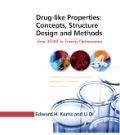
Drug-like properties: concepts, structure, design and methods : from ADME to toxicity optimization
Kerns, Edward H.
Di, Li
Of the thousands of novel compounds that a drug discovery project team invents and that bind to the therapeutic target, typically only a fraction of these have sufficient ADME/Tox properties to become a drug product. Understanding ADME/Tox is critical for all drug researchers, owing to its increasing importance in advancing high quality candidates to clinical studies and the processes of drug discovery. If the properties are weak, the candidate will have a high risk of failure or be less desirable as a drug product. This book is a tool andresource for scientists engaged in, or preparing for, the selection and optimization process. The authors describe how properties affect in vivo pharmacological activity and impact in vitro assays. Individual drug-like properties arediscussed from a practical point of view, such as solubility, permeability and metabolic stability, with regard to fundamental understanding, applications of property data in drug discovery and examples of structural modifications that have achieved improved property performance. The authors also review various methods for the screening (high throughput), diagnosis (medium throughput) and in-depth (low throughput) analysis of drug properties. INDICE: Preface..Introductory Concepts.1. Introduction.2. The Advantages of Good Drug-like Properties.3. Barriers to Drug Exposure in Living Systems..Physicochemical Properties.4. Rules for Rapid Property Profiling From Structure.5. Lipophilicity.6. pKa.7. Solubility.8. Permeability..Disposition, Metabolismand Safety.9. Transporters.10. Blood-Brain Barrier.11. Metabolic Stability.12. Plasma Stability.13. Solution Stability.14. Plasma Protein Binding.15. Cytochrome P450 Inhibition.16. hERG Blocking.17. Toxicity.18. Integrity and Purity.19. Pharmacokinetics.20. Lead-like Compounds.21. Strategies for Integrating Drug-Like Properties Into Drug Discovery..Methods.22. Methods for Profiling Drug-like Properties: General Concepts.23. Lipophilicity Methods.24. pKa Methods.25. Solubility Methods.26. Permeability Methods.27. Transporter Methods.28. Blood-Brain Barrier Methods.29. Metabolic Stability Methods.30. Plasma Stability Methods.31. Solution Stability Methods.32. CYP Inhibition Methods.33. Plasma Protein Binding Methods.34. hERG Methods.35. Toxicity Methods.36. Integrity andPurity Methods.37. Pharmacokinetics Methods..Specific Topics.38. Diagnosing and Improving Pharmacokinetic Performance.39. Prodrugs.40. Effects of Properties on Biological Assays.41. Formulation..Answers to Problems.Appendix I: General References.Appendix II: Glossary.
- ISBN: 978-0-1236-9520-8
- Editorial: Elsevier
- Encuadernacion: Cartoné
- Páginas: 526
- Fecha Publicación: 01/01/2008
- Nº Volúmenes: 1
- Idioma: Inglés
